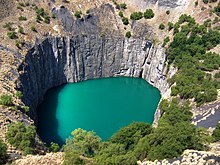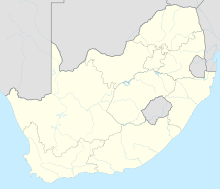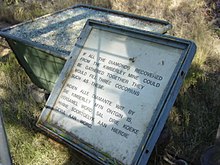
The De Beers Group is a South African–British corporation that specializes in the diamond industry, including mining, retail, inscription, grading, trading and industrial diamond manufacturing. The company is active in open-pit, underground, large-scale alluvial and coastal mining. It operates in 35 countries with mining taking place in Botswana, Namibia, South Africa, and Canada. It also has an artisanal mining business, Gemfair, which operates in Sierra Leone.

Underground hard-rock mining refers to various underground mining techniques used to excavate "hard" minerals, usually those containing metals, such as ore containing gold, silver, iron, copper, zinc, nickel, tin, and lead. It also involves the same techniques used to excavate ores of gems, such as diamonds and rubies. Soft-rock mining refers to the excavation of softer minerals, such as salt, coal, and oil sands.
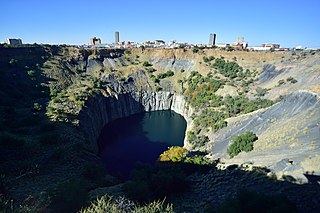
Kimberley is the capital and largest city of the Northern Cape province of South Africa. It is located approximately 110 km east of the confluence of the Vaal and Orange Rivers. The city has considerable historical significance due to its diamond mining past and the siege during the Second Anglo-Boer war. British businessmen Cecil Rhodes and Barney Barnato made their fortunes in Kimberley, and Rhodes established the De Beers diamond company in the early days of the mining town.
Jagersfontein is a small town in the Free State province of South Africa.

The Excelsior Diamond is a gem-quality diamond, and was the largest known diamond in the world from the time of its discovery in 1893 until 1905, when the Cullinan Diamond was found. It was found on June 30, 1893, at the Jagersfontein Mine in South Africa, 130 kilometres south east of Kimberley whose fame as a diamond mining center always overshadowed that of Jagersfontein. It had a blue-white tint and weighed 971 old carats or 995.2 metric carats. The Excelsior rates as the fourth largest rough diamond of gem quality ever found. It was ultimately cut into ten stones weighing from 13 to 68 carats.
Kleinzee is a small village on the west coast of the Northern Cape province in South Africa at the mouth of the Buffels River. It is just south of Grootmis, 72 km south-east of Port Nolloth and 105 km west of Springbok. Previously a closed company town, it was known for its diamond-mining operations until the 2000s.

The Mineral Revolution is a term used by historians to refer to the rapid industrialisation and economic changes which occurred in South Africa from the 1860s onwards. The Mineral Revolution was largely driven by the need to create a permanent workforce to work in the mining industry, and saw South Africa transformed from a patchwork of agrarian states to a unified, industrial nation. In political terms, the Mineral Revolution had a significant impact on diplomacy and military affairs. Finally, the policies and events of the Mineral Revolution had an increasingly negative impact on race relations in South Africa, and formed the basis of the apartheid system, which dominated South African society for a century. The Mineral Revolution was caused by the discovery of diamonds in Kimberly in 1867 and also by the discovery of gold in Witwatersrand in 1886. The mineral mining revolution laid the foundations of racial segregation and the control of white South Africans over black South Africans. The Mineral Revolution changed South Africa from being an agricultural society to becoming the largest gold producing country in the world.

Reikaeletse Mine is a diamond mine situated in the Free State province, about 80 km from Kimberley, South Africa. It is one of the many Kimberley mines of which Kimberley mine, de Beers mine, Dutoitspan, Bultfontein and Wesselton are its more famous neighbours.

Jagersfontein Mine was an open-pit mine in South Africa, located close to the town of Jagersfontein and about 110 kilometres south-west of Bloemfontein. Since it was first established, two of the ten biggest diamonds ever discovered, the Excelsior and the Reitz, were mined from Jagersfontein. The term "Jagers" has since been coined to denote the distinctive faint bluish tint of the gems from this mine. Among geologists, Jagersfontein is known as a kimberlite pipe, and a prime locality for mantle xenoliths, some of which are believed to have come from depths of 300–500 km (190–310 mi).

Mining in South Africa was once the main driving force behind the history and development of Africa's most advanced and richest economy. Large-scale and profitable mining started with the discovery of a diamond on the banks of the Orange River in 1867 by Erasmus Jacobs and the subsequent discovery of the Kimberley pipes a few years later. Gold rushes to Pilgrim's Rest and Barberton were precursors to the biggest discovery of all, the Main Reef/Main Reef Leader on Gerhardus Oosthuizen's farm Langlaagte, Portion C, in 1886, which kicked off the Witwatersrand Gold Rush and the subsequent rapid development of the gold field there.
The Marange diamond fields are an area of widespread small-scale diamond production in Chiadzwa, Mutare District, Zimbabwe. 'Although estimates of the reserves contained in this area vary wildly, some have suggested that it could be home to one of the world's richest diamond deposits'. The hugely prolific fields are regarded by some experts as the world's biggest diamond find in more than a century. Production from Marange is controversial due to ongoing legal wrangles and government crackdowns on illegal miners and allegations of forced labour. In terms of carats produced, the Marange field is the largest diamond-producing project in the world, estimated to have produced 16.9 million carats in 2013, or 13% of global rough diamond supply. Marange is estimated to have produced 12 million carats in 2012, 8.7 million carats in 2011, and 8.2 million carats in 2010. While some diamond mines produce rough valued at over $1000 per carat, average production at Marange is estimated at under $50 per carat.
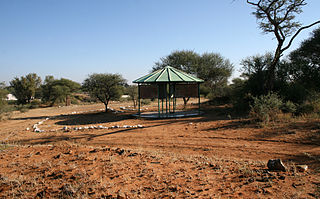
Canteen Kopje is an archaeological site, formally protected as a grade 2 provincial heritage site, and approved in 2017 for re-grading to national status, situated outside Barkly West in the Northern Cape, South Africa. The place was previously known as Klipdrift, meaning stony drift, a translation from a still earlier !Ora name, !a |aub. Canteen Kopje is best known for its long and exceptionally rich Earlier Stone Age sequence, spanning circa >0.5 to 1.7 million years, occurring within gravels exposed in late nineteenth and early twentieth century mining pits. Also attracting attention are more recent archaeological levels in the overlying Hutton Sands, which contain material known as Fauresmith, Middle Stone Age, Later Stone Age, and late Iron Age with evidence of protocolonial and colonial contact and interaction, probably, with nineteenth century diamond diggers.

Gardner Frederick Williams was an American mining engineer and author, and the first properly trained mining engineer to be appointed in South Africa.

The mining industry of Sierra Leone accounted for 4.5 percent of the country's GDP in 2007 and minerals made up 79 percent of total export revenue with diamonds accounting for 46 percent of export revenue in 2008. The main minerals mined in Sierra Leone are diamonds, rutile, bauxite, gold, iron and limonite.

The Cape Government Railways 0-4-0ST 1881 Coffee Pot was a South African steam locomotive from the pre-Union era in the Cape of Good Hope.
The Coalbrook mining disaster is the worst mining accident in the history of South Africa. The disaster occurred in the Coalbrook coal mine of Clydesdale Colliery on 21 January 1960 at around 19:00 when approximately 900 pillars caved in, almost 180 metres (590 ft) underground. The mine is situated in the Northern Free State, 21 kilometres (13 mi) south west of Vereeniging. About 1,000 miners were in the mine at the time and 437 died after being trapped, while the rest escaped through an incline shaft. The miners were suffocated by methane gas and crushed to death by rockfall.
The mining industry of Lesotho is mostly concentrated on diamond mining and as such the mining sector in the country has not played any significant role in furthering its economy. Apart from diamonds, the country's main mineral resources have been identified as base metals, clays, dimension stone, sand, gravel and uranium. The lack of initiative to extract other minerals commercially is mainly attributed to the inadequacy of infrastructure and finances. Between 2000 and 2011, the percentage of GDP contributed by diamond mining to Lesotho's economy rose from "virtually zero" to about 4%.

Francis Oats was a Cornish miner who became chairman of De Beers diamond company. He made extensive investments in the Cornish tin mining industry, which collapsed after he had died. He is known for Porthledden, a mansion he built at the tip of Cornwall.
The 2022 Jagersfontein Tailings Dam Collapse was a structural failure of a mine tailings dam near Jagersfontein, located in the Free State province of South Africa, resulting in a mudslide.
